Super Easy Cold-Compost-Pile Harvest
- Megan Christian
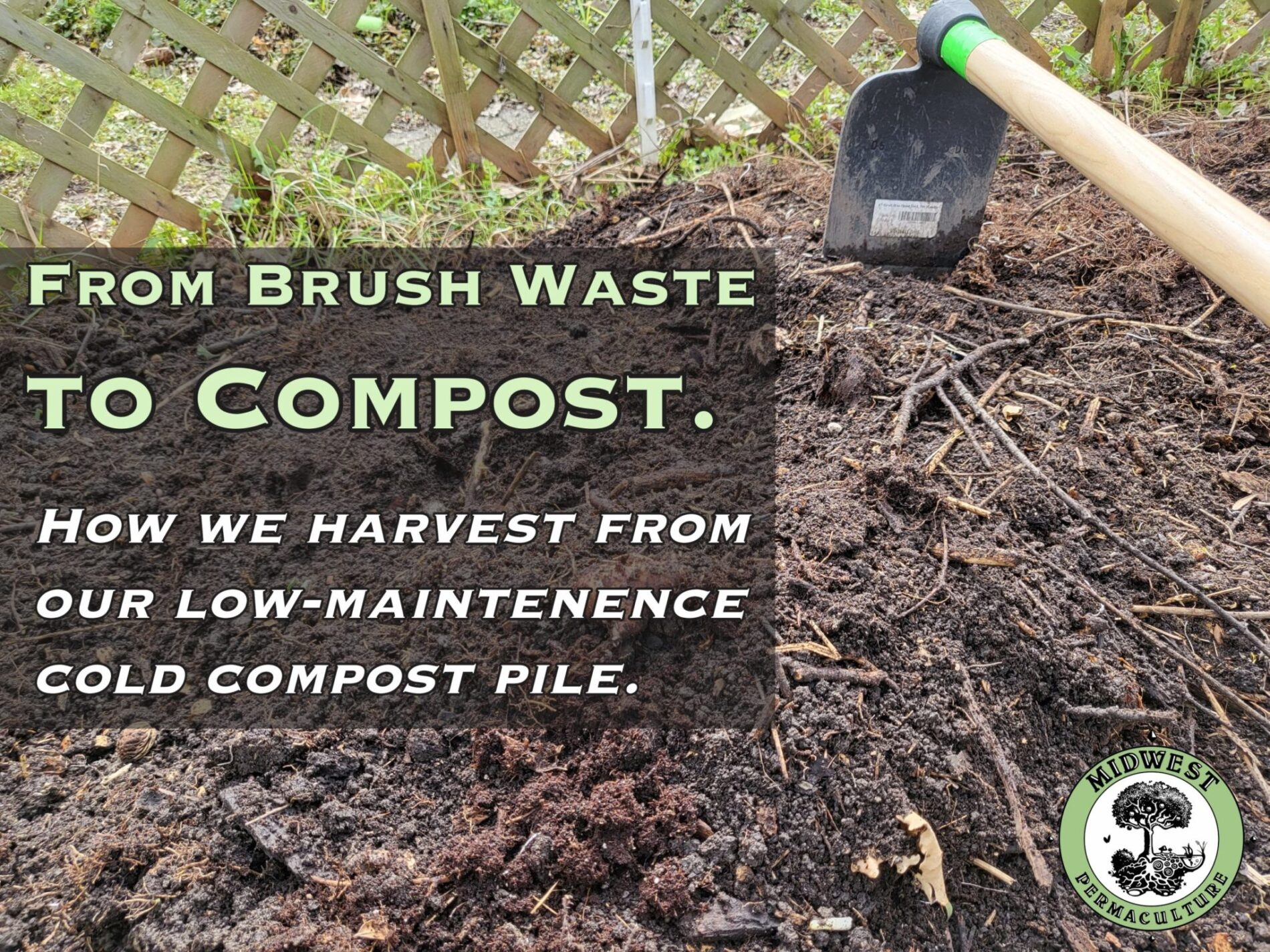
Spring is here at Midwest Permaculture. It’s time for the annual harvest from the bottom of our cold compost pile. Along with beautiful compost, we are always pleasantly surprised by another yield uncovered.
We started this area as a hugelkultur bed with a moat on three sides to retain water. Once filled with logs, sticks, and covered in soil, we planted the bed with Jerusalem artichokes and other plants for quite a few years before it was eventually repurposed into our cold compost space.
As we trim bushes, branches, and other rigid/reedy materials from our yard throughout the year, we place them here. We’ll also through in some lawn clippings and weeds over the summer and dried leaves in the fall. We don’t turn or regulate this pile in any way; we only rely on time and the life in the soil to break the contents down.

Over the year, the material in contact with the soil slowly gets eaten up and turned into humus. In the spring, we pull back the top mass of the pile to uncover the crumbly rich organic matter that collects underneath. This is a gold mine of nutrients and a wonderful soil texturizer for our garden beds.
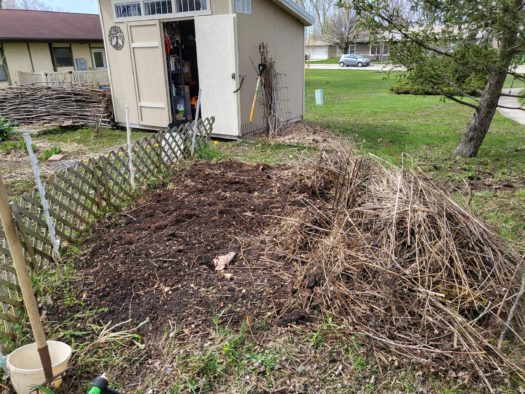
We scrape off the top layer of composted organic matter down to the topsoil (each year, there is usually about a 2-inch thick layer of compost)…

…screen it over a wheelbarrow to remove anything that hasn’t broken down enough…

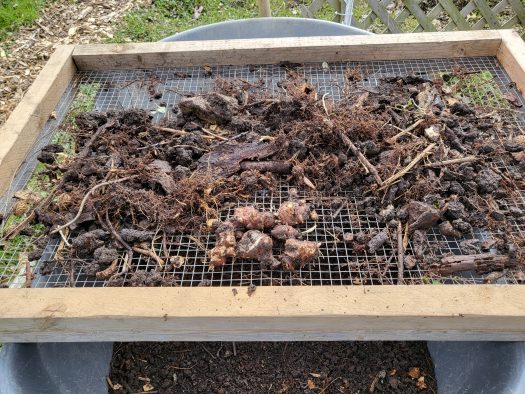
…and use it to top off our garden beds. This compost will provide most of the fertility we need for the year and creates a perfect seedbed!
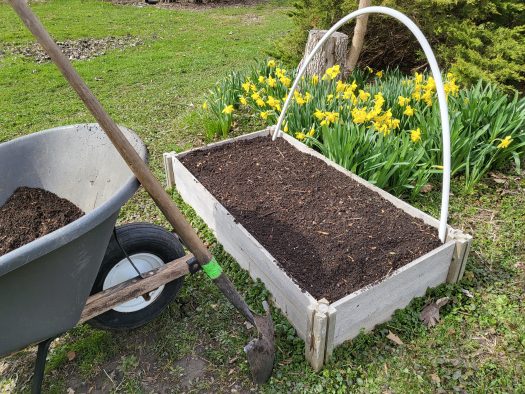
This year after removing the compost, we were curious to see if there was any woody material left from the original hugelkultur.
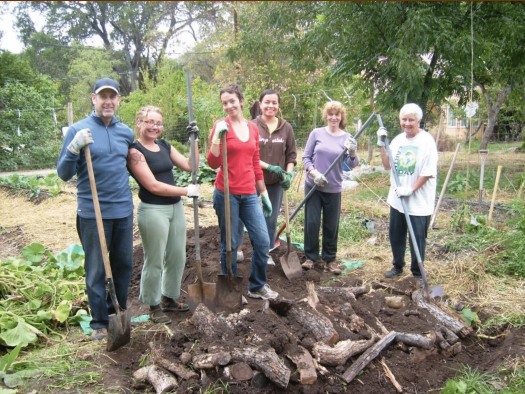
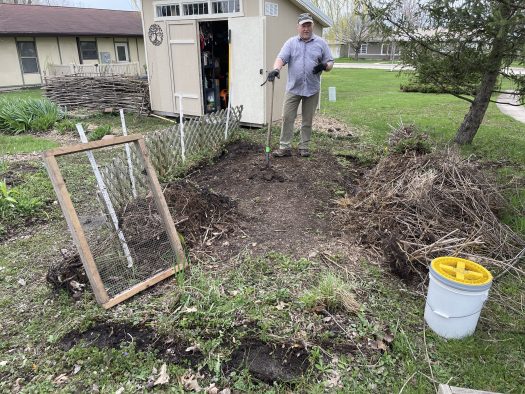
So Bill dug a hole to see what remained of the buried wood.

It turns out that everything has completely broken down. The decomposition of the large logs and sticks we buried here 11-years ago has led to the clay-heavy soil gaining incredible texture and drainage. It now does a great job supporting the growth of the other unexpected yield we find here each year–Jerusalem Artichoke tubers.
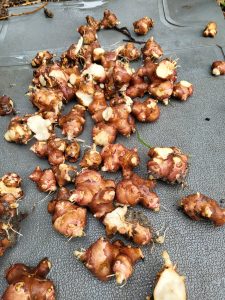
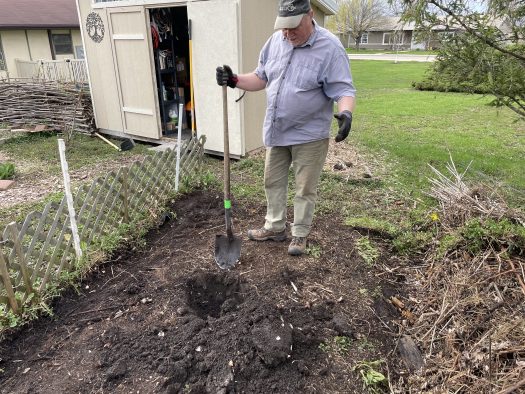
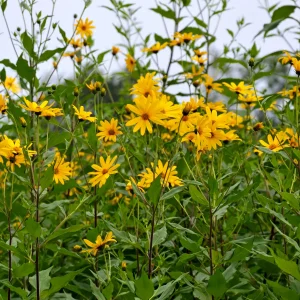
Although only a few of the Jerusalem Artichokes plants come up through or around the brush pile each year, the edible tubers of this tenacious plant continue to multiply in the soft organic soil below. With almost every shovel full of composted organic matter, more tubers are harvested.
It is reassuring to know that we have this abundance of food growing each year, and it doesn’t require any active attention. Now, on to process the tubers!
This cold-compost brush pile is a low-effort way to create a valuable soil additive with ease, and all we are doing is harvesting the carbon (from branches, sticks, leaves, weeds) that comes off of our own property. It is our carbon. We grew it, and it is so satisfying to turn it into a soil additive.
Despite only needing attention once a year when we harvest, this cold compost pile provides a good amount of high-quality organic matter and nutrients. Throughout the process, our wastes become resources, work is minimized, and the clay soil is turned into a crumbly loam.
What yields other than Jerusalem Artichokes could we produce underneath a system like this?

7 thoughts on “Super Easy Cold-Compost-Pile Harvest”
The hugel beds I have grown some mint in are left alone by the critters. I also harvest the mint in the fall and place it with equipment and materials for storage. Haven’t had a mouse nest extraction since I started the practice.
I would also like some suggestions on preparing the Sun Choke tubers. The inulin starch is very hard to digest and a super methane producer!! Has anyone pickled them or found some other way of preparing them that makes them safe for company??
We have had some good luck with pickling! It really helps break down those starches and makes the tubers more easily digestible.
I have several hugels going now. One thing that has occurred is that several critters have found the wood pile an interesting camp site. I have found tunneling going on for two years running. The last hugel I pounded the wood down pretty aggressively as I built it to discourage the vole or ground squirrel (haven’t spotted my neighbor yet!) but there is evidence of a winter den in one of the hugels. Any suggestions? There hasn’t been too much destruction – but my plans have been undercut each year by some surprise of another. Last year the beans took everything else down! No corn or squash left under their mighty grip! It is a slow learning process!
Oh how I love: less is more. To take something that seemed overwhelming to tend to and care for and to make it manageable by letting nature do what it was created to do is magnificent and is a game changer for my gardening projects and plans. Also, to see in person how clay filled the soil is there and to see the amount of supportive organic matter created by magic is additionally impactful. I buried wood in my beds two seasons ago and it’s tempting to dig up to see the progress but I don’t want to disrupt my layers. I still may do a test peek but seeing through you is believing! Thanks for sharing.
This is an incredible article. It has made me remember the time we added chopped materials from trim brushes to that pile in October , 2019 with Bill & Becky. That pile is super rich with organic matter. It’s indeed a good mine. Here thinking of the Jerusalem Artichokes.
Ooh yes, I will be setting up a hugelkultur this year. To answer the question above, am thinking of putting Turmeric, Ginger & sweet potatoes.
Did you grow ginger, turmeric or sweet potatoes? I’d love to grow those but thought it was to cold in the Chicago area.